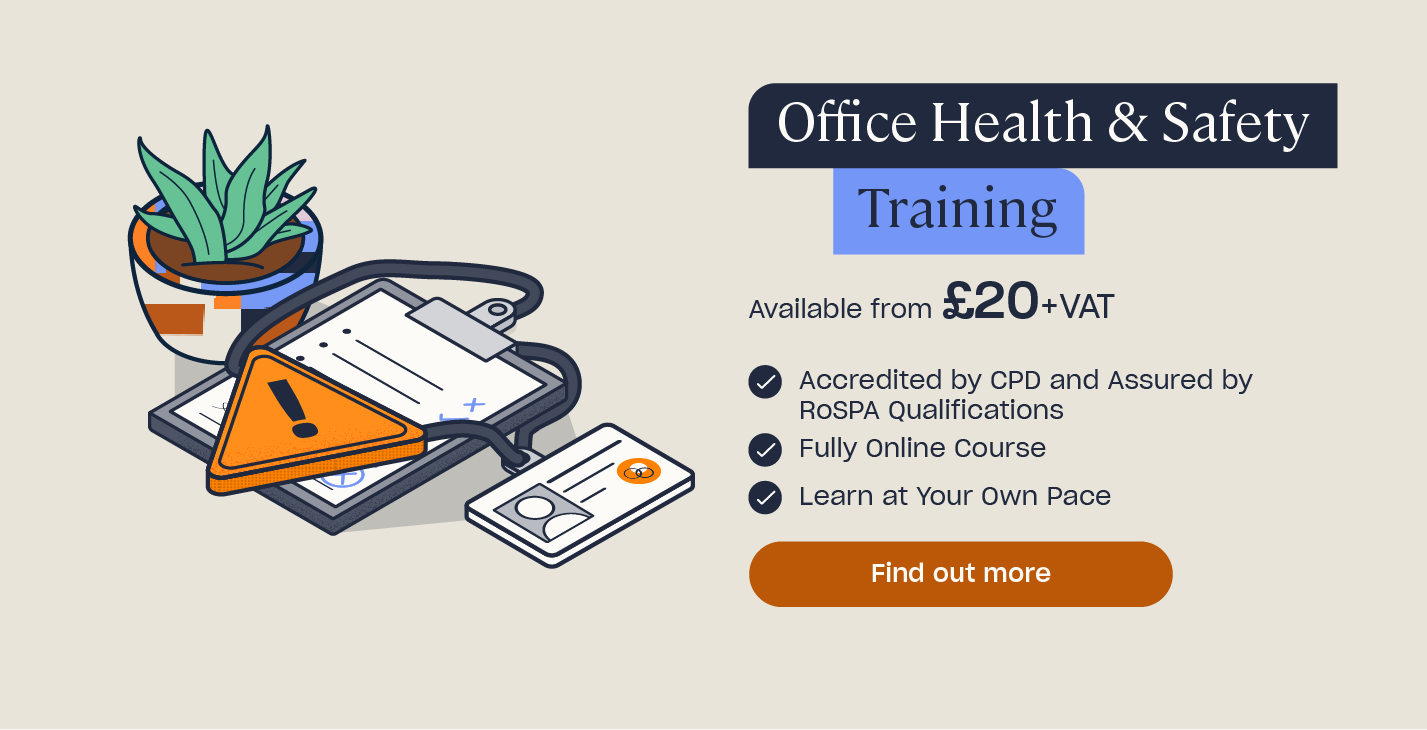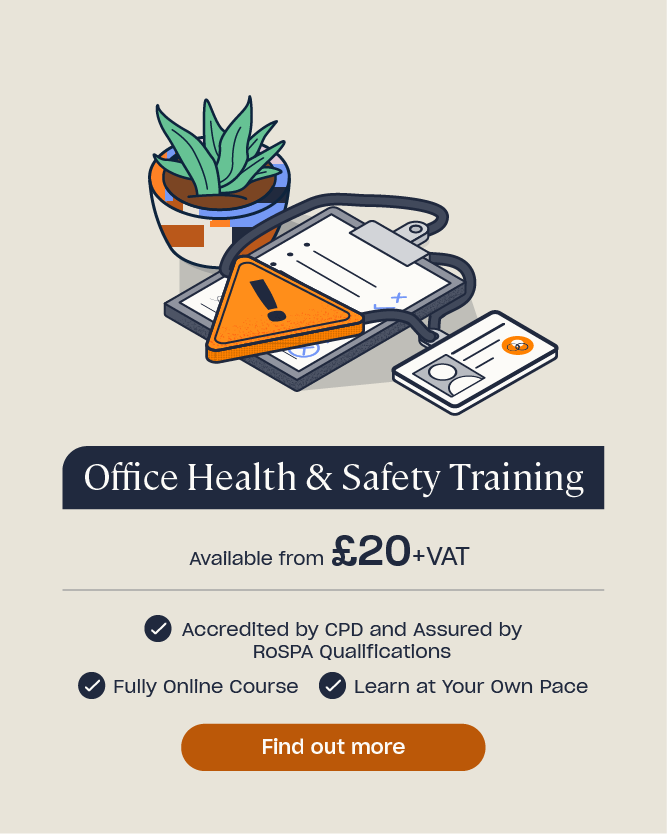The Most Common Office Injuries and How To Prevent Them
Work-related injuries can have a major impact on your overall business, as well as the personal impact on those harmed. According to the HSE’s annual Labour Force Survey, around 560,000 workers sustain a non-fatal injury at work each year, with more than 120,000 requiring more than seven days off work to recover. In total, around 3.7 million working days are lost yearly due to work-related injury or illness.
As an employer you are legally responsible for creating a healthy and safe workplace by identifying potential dangers and preventing them from causing harm. In this article, we will outline the most common office injuries and how you can go about preventing them, in order to keep everyone in your workplace safe and well.
What are the Most Common Office Injuries?
Each workplace comes with its own set of dangers that could cause its employees, or anyone else who enters the premises, harm. While the possible causes of injury in an office may not be as obvious as in some other workplaces – such as on a construction site or in a kitchen – serious injuries can and do occur.
Because the dangers in an office environment aren’t always obvious, employees and employers alike may not be on the lookout for them or fail to recognise them, which is how injuries occur. As an employer, then, while it is your responsibility to identify and prevent causes of injuries, you should also ensure your employees are able to do the same, in order to keep them as safe as possible.
You can test your ability to identify office-based hazards using our Office Health and Safety Quiz, here.
The following list outlines the most common causes of office injuries and ways to prevent them from happening. You should look for these hazards in your own workplace so you can take steps to prevent them from causing injuries to anyone in your office.
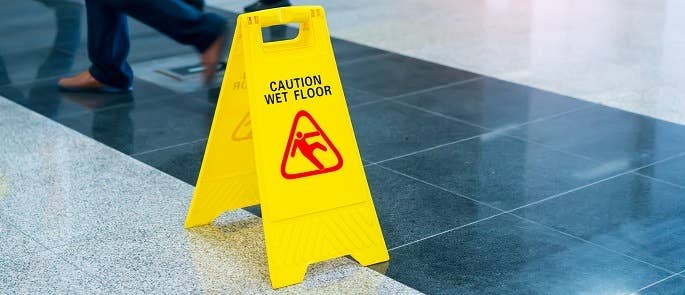
Slips, Trips and Falls
According to the Health and Safety Executive (HSE), slips, trips and falls are the most common cause of major injury in UK workplaces. They can also lead to more serious incidents occurring, such as a fall from height.
When considering hazards in your workplace that could lead to slips, trips and falls, think about:
- Slippery surfaces: is there anything that builds up outside your office building that could lead someone to slip, such as water when it rains, piles of leaves, mud or ice? Does mopping the inside of the office take place when staff members are still walking around?
- Uneven surfaces: are there any changes in surfaces that may be hard to spot, such as small slopes or steps in entryways? Are there any potholes or uneven paving outside that someone could trip on?
- Trip hazards: does your office space often become cluttered? Are there trailing cables, rubbish or anything else on the floor that someone could trip on? Do office deliveries get left in the doorway? Are the carpets and mats secure or are the edges curling and is there any loose or cracked tiling, particularly in bathrooms or kitchens where they could easily also become wet?
- Handrails: a suitable handrail is essential for all stairways as it can prevent someone from tripping on the stairs and, on landings, they can also prevent a fall from height. Are your office’s handrails easy for all employees to reach and use?
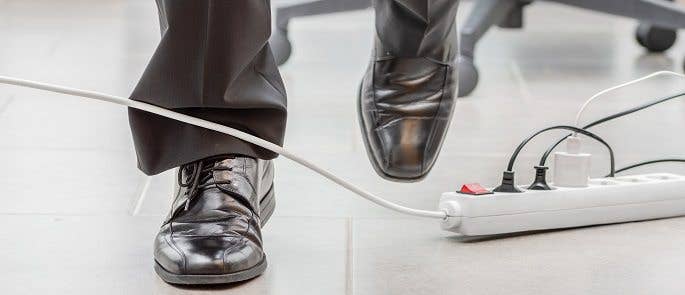
Preventing Slip, Trip and Fall Injuries
To reduce the likelihood of someone being injured by a slip, trip or fall in your office, you should:
- Keep the office clear of clutter: encourage staff to keep wires organised and under their desk and if deliveries are usually left in your entryway, designate a specific area for them that is out of the way of foot-traffic. Make sure to provide enough rubbish bins to avoid litter on floors.
- Clean entryways regularly: remove any water or debris that could cause slips on a daily basis. Consider implementing a specific winter cleaning procedure, including regular gritting if your entryways are prone to ice. Place floor mats at the entrances to the office to stop water, mud or other slippery substances from entering.
- Highlight subtle changes in floor levels: you could use lighting or contrasting paint to highlight any slopes or steps that are difficult to see.
- Fix floor damage as soon as possible: this includes damage inside the premises, such as to tiles, carpets and mats and any potholes or broken surfaces outside. Cordon these areas off until they can be fixed.
- Where possible, use slip-resistant materials for your office floors: this is particularly important on stairs and fire escapes.
- Ensure cleaning schedules are aligned with staff safety: make sure floors are not mopped until all staff have left the office and that equipment and processes are effective. Using the wrong tools or techniques to clean can lead to slippery floors.
- Implement a ‘see it, sort it’ policy among staff for spillages and trip hazards: you need to make sure you provide them with the necessary equipment to do this, such as mop buckets, cleaning cloths, etc.
Looking to Learn More?
Our Office Health and Safety course teaches you how to identify health and safety risks in an office environment and what employees can do to prevent their work and behaviour from causing them, or others, harm.
Improper Use of Display Screen Equipment (DSE)
DSE refers to electronics including computers, laptops, tablets and smartphones. By law, employers must protect their employees from health risks created by working with DSE if those workers use DSE for more than one hour a day. In an office setting, this is likely to be the case for most employees.
DSE related injuries are mainly caused by having an unsuitable desk layout, an uncomfortable chair or needing to bend and reach your body into uncomfortable positions.
Having an incorrect DSE setup or using the setup incorrectly can lead to health problems, some of which you may not notice right away, including:
- Pain in the neck, shoulders, arms, back, hands and wrists. This pain can develop into more serious long-term conditions, like carpal tunnel syndrome.
- Musculoskeletal disorders affecting the bones, joints and/or muscles.
- Eye strain, potentially leading to tired eyes, headaches and even temporary vision problems.
- Stress and/or fatigue, which could increase the risk of employees having incidents that cause further injury.
If you’d like to learn how to perform a thorough DSE risk assessment, check out our article which provides you with a free DSE risk assessment template, here.

Preventing DSE Injuries
As an employer of DSE users, you are required to fulfil certain duties to keep your employees safe from harm while using DSE. These duties include:
- Performing an assessment of employees’ DSE setup (including for remote workers). Check out our article on how to perform a workspace assessment, here.
- Providing eye tests for workers who want one.
- Providing training and information on the proper setup and use of DSE for employees.
- Scheduling annual refresher training and/or assessments to ensure employees are maintaining safe practices.
You must also implement proportionate control measures to reduce the risks workers face to their health when using DSE. These may include:
- Allowing employees to take regular breaks from using DSE.
- Accommodating for any special requirements a staff member may require, such as foot or wrist rests or a laptop stand.
- Providing ergonomic desk furniture and anti-glare monitor screens.
- Providing adequate central lighting and task lighting at each workstation.
Even if you provide your employees with all of the correct DSE equipment, if they don’t use it correctly, or don’t know how to, their health can still be harmed. This is why training staff on the risks of DSE and proper use of equipment is vital.
DSE training should provide guidance on correct posture, how to adjust equipment and furniture, correct desk setup, breaks and suitable lighting.
DSE Course
Our Display Screen Equipment (DSE) course teaches you about the health risks associated with DSE and how to set up your workspace to reduce the risk of harm, as well as how to follow safe practices when working with DSE.
Manual Handling
Manual handling is the transporting or supporting of a load by hand or using bodily force, including by lifting, pushing, pulling, carrying, putting down and moving the load.
While you may not think that any manual handling you do in an office would be enough to cause injury, just carrying a single cardboard box of papers incorrectly can be enough to do harm.
Improper manual handling can lead to sprains and strains and injuries to most parts of the body, but particularly to the back, neck and hands. Over time, these can develop into more serious, long-term conditions such as musculoskeletal disorders (MSDs) or repetitive strain injuries (RSIs).
Preventing Manual Handling Injuries
Manual handling should only be performed when no other option is available. Where it is necessary, there are some control measures that can be put in place to reduce the risk of injury to employees. When manual handling, employees should:
- Only carry what they can lift comfortably, breaking things down into smaller loads where possible.
- Carry heavier loads with another person.
- Clear a path for themselves before carrying a load.
- Use manual handling aids such as trolleys to perform the task.
You should provide manual handling training for anyone who needs to perform it as part of their job role to teach them the correct handling techniques to avoid injury.

Manual Handling Course
Our Manual Handling course teaches you the risks involved in manual handling and how to put control measures in place to prevent harm. It also provides practical guidance on how to safely carry out manual handling tasks which is beneficial for any employee who may need to perform manual handling at work.
Falls From Height
Falls from height can lead to serious injuries, including broken bones, fractures and head injuries, even in an office environment. In fact, a fall from as little as two metres can cause serious, even fatal injuries to the person involved.
In an office, employees may be inclined to stand on a chair or desk to reach something high up instead of using proper equipment – particularly if they don’t know where to find that equipment. Unfortunately, these are often unstable and offer nothing to hold on to for support which can easily cause someone to lose their balance, resulting in a potentially serious injury.
Falls from stairs are another common cause of injuries in offices and these can result from an initial slip or trip.
Preventing Fall From Height Injuries
To prevent falls from height, make sure that equipment for working from height, namely a proper ladder or stepladder, is available to employees and that they know where to find it, along with how to use it. You may need to provide employee training to achieve this.
While you can provide your employees with the correct tools for working safely at height, you cannot guarantee they will use them correctly. Providing training in working at height will make them aware of the risks and how to manage them, for example by teaching them best practice for using equipment.
Some safety tips when using ladders include maintaining three points of contact with it at all times (i.e. two feet and one hand) and never over-reaching on a ladder, as this can cause it to tip. You can use our free ladder inspection checklist to help you and your team stay safe whenever a ladder is needed.
To prevent falls on stairs, handrails are essential, as well as ensuring that each step is easy to see and the steps are well maintained and surfaced with slip-resistant material. We outline more control measures you can implement to prevent injuries to employees working at height in our article, here.
Electrical Accidents
Most office spaces are full of electrical equipment and it only takes a voltage as low as 50 volts to produce an electric shock. An electric shock can send a person into cardiac arrest, ultimately resulting in death unless that person receives CPR immediately.
Even if an electric shock is not fatal, it can cause serious injuries, including:
- Electrical burns. These are deep burns that can be permanently disabling. While burns are more common at higher voltages, they can still be caused by domestic electricity supplies when the current flows for more than a few fractions of a second.
- Thermal burns. Thermal burns are caused by hot surfaces, such as those created by overloaded, faulty, poorly maintained or shorted electrical equipment. If electrics are allowed to get too hot, they can even explode or set on fire.
- Muscle spasms. Electric shocks can produce strong muscle spasms that can be enough to break bones and cause dislocations.
Electric shocks can also lead to further injury as they often cause the casualty to fall over which could cause a head injury or damage to other body parts on impact with the ground.
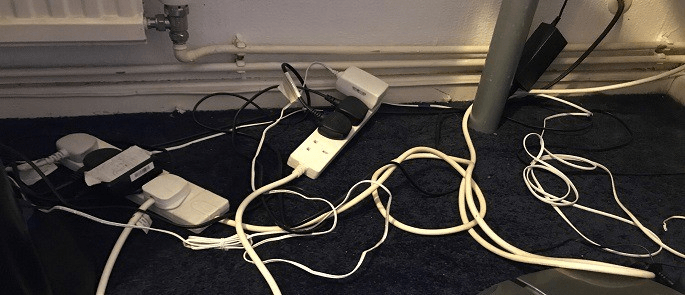
Preventing Electrical Accident Injuries
You can prevent injuries caused by electrical equipment in your office by keeping equipment well maintained, including performing regular checks of equipment for any faults, such as exposed wires.
You should also dispose of and replace any faulty equipment as soon as you discover it and ensure that all equipment has a PAT sticker to verify that it has been rested for electrical safety.
Ensure that employees perform their own regular checks of equipment, particularly if they work from home and to flag any issues immediately – for example, if they think any of their equipment is overheating. You should also make sure that they are not overloading plug sockets as this can cause equipment to short, creating a risk of electric shock.
Workplace First Aid Course
While many office injuries are preventable, unfortunately some will inevitably occur. Our Workplace First Aid course teaches you how to recognise various injuries and illnesses and provide the most appropriate first aid response for each, including in life-threatening situations such as cardiac arrest.
As an employer, your responsibility is to protect those in your workplace from harm in any way you can. Being aware of the most common causes of injury in an office will allow you to implement control measures to prevent them from happening to your employees or anyone else who visits your place of work.
Further Resources:
- Office Hazard Checklist for Health and Safety
- Health and Safety When Working With Computers: An Office Guide
- How to Conduct a First Aid Needs Assessment – Free Template
- Slips, Trips and Falls Quiz
- Tips for Preventing Slips, Trips, and Falls in the Workplace
- Workplace First Aid Quiz
- What Are the Consequences Of Poor Health & Safety Procedures?


